- Author: Kathy Keatley Garvey
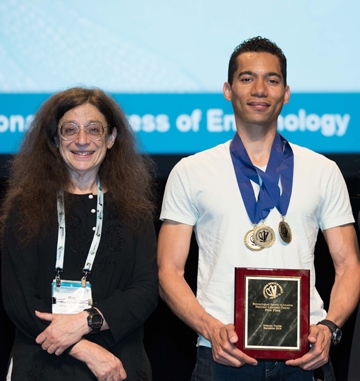
The UC Davis Linnaean Games Team has successfully defended its national championship.
The team, comprised of three UC Davis Department of Entomology and Nematology graduate students, defeated the University of Georgia in the championship round.
The annual Linnaean Games, sponsored by the Entomological Society of America (ESA), took place at ESA's recent meeting in Orlando, Fla., held in conjunction with the International Congress of Entomology meeting.
UC Davis team members are captain Ralph Washington, a third-year graduate student; Brendon Boudinot, a third-year graduate student; and Emily Bick, a second-year graduate student. They defeated the University of Georgia, the 2012 winner, in the championship match (score, UC Davis 145; Georgia, 55). The UC Davis entomologists earlier outscored Ohio State University, North Carolina State University (champions in 2014), and Texas A&M in advancing to the finals.
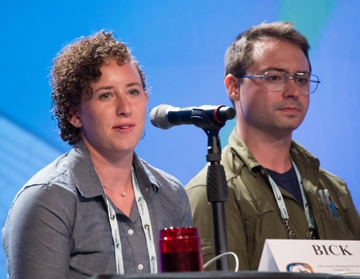
Washington is studying for his doctorate with major professors Steve Nadler and Brian Johnson, who respectively specialize in systematics and evolutionary biology of nematodes and the evolution, behavior, genetics, and health of honey bees; Boudinot with major professor Phil Ward, systematics and evolutionary biology of ants; and Bick, with major professor Christian Nansen. Bick is working on ecosystem models to optimize pest management in two systems: invasive aquatic weed species water hyacinth and its biological control agent, Neochetina bruchi; and working to control Lygus bugs using alfalfa as a trap crop in strawberries. UC Davis Extension entomologist Larry Godfrey serves as the advisor.

- Question: “You have just moved into an apartment that has been vacant for weeks but whose prior owners had several cats and dogs. A very few days after you move in you are bitten by a huge number of cat fleas that seem to have appeared out of nowhere. What characteristic behavior of cat fleas biology is probably responsible for this?”
Answer: “Cat flea pupae eclose in response to the presence of a host.” -
Question: Insects inhabiting a very thin water film such as splash zones marginal to streams are called what?
Answer: Madicoles - Question: The insect order Notoptera unites what two former insect orders?
Answer: Notoptera unites Mantophasmatodea and Grylloblattodea - Question: What are the two obvious clinical symptoms that someone is suffering from onchocerciasis?
Answer: Blindness and hanging tissue around lymph nodes, often times the scrotum. - Question: What is the common name for the zygentoman pest that thrives in high humidity and high temperatures and is often found in boiler rooms?
Answer: The firebrat, Thermobia domestica. - Question: Projection neurons travel across what two major regions of the insect brain?
Answer: The protocerebrum and the deutocerebrum.
(Editor's Note: The video of the 2016 Linnaean Games' championship match will soon be posted on the ESA YouTube channel. Meanwhile, here's a link to the 2015 championship game, won by UC Davis. https://www.youtube.com/playlist?list=PL21ACF32985978D25
Related Links:

- Author: Kathy Keatley Garvey
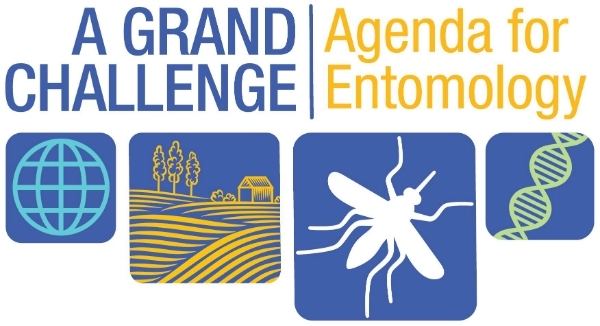
This was the inaugural meeting of the Grand Challenges in Entomology Initiative. ESA is committed to thinking and acting more globally, enhancing its influence by establishing a science policy program, identifying attainable challenges for entomology that could lead to sustainable solutions for some of the world's important insect-based problems, and more effectively communicating what entomologists do to improve the human condition. At the invitation-only Summit, the participants explored “three broad issues of major global importance to which entomology can make a unique and powerful contribution”:
- Sustainable agriculture – global hunger, food security, and natural resources preservation
- Public health related to vector-borne diseases
- Invasive insect species – global trade, biodiversity, and climate change
ESA president May Berenbaum, professor and department head, University of Illinois at Urbana-Champaign, and Zalom welcomed the crowd.
Zalom co-chaired the Summit with
- Silvia Dorn, professor of applied entomology, ETH Zurich; past president of the Swiss Society of Phytomedicine; and fellow of the ESA, Royal Entomological Society, and International Society of Horticultural Sciences.
- Le Kang, director of the Institute of Zoology and president of Beijing Institutes of Life Science, Chinese Academy of Sciences; current president of the Entomological Society of China; and fellow of ESA and TWAS (formerly Third World Academy of Sciences)
- Antônio R. Panizzi, senior scientist, Embrapa and professor, Federal University at Curitiba; and former president of the Entomological Society of Brazil
- John Pickett, Michael Elliott Distinguished Research Fellow at Rothamsted Research; immediate past president of the Royal Entomological Society; and fellow of ESA and Royal Entomological Society
Introductory comments on behalf of the co-chairs emphasized that “leadership meetings such as this one provide an opportunity for connectivity among the world's entomology societies."
This was the very first International Entomology Leadership Summit at an ICE meeting. It was aimed at connecting leaders from the entomological community worldwide and discussing how entomologists "can make unique and powerful contributions toward solving some of the world's insect-based problems, a goal that can be achieved only through collaborative, international efforts," officials said. The last ICE meeting held in the United States (Washngton, D.C.) took place 40 years ago.
Chemical ecologist Walter Leal, distinguished professor in the UC Davis Department of Molecular and Cellular Biology, co-chaired ICE 2016 with Alvin Simmons, research entomologist with the United States Department of Agriculture's Agricultural Research Service (USDA/ARS), U.S. Vegetable Laboratory in Charleston, South Carolina.
Leal said that 6,682 delegates from 102 countries attended the historical ICE 2016 meeting in Orlando. “Alvin and I were very glad to hear about the level of satisfaction: 87 percent,” Leal said, adding that "we worked very hard to prepare for the Congress and promised it would be a historic event: mission accomplished!”
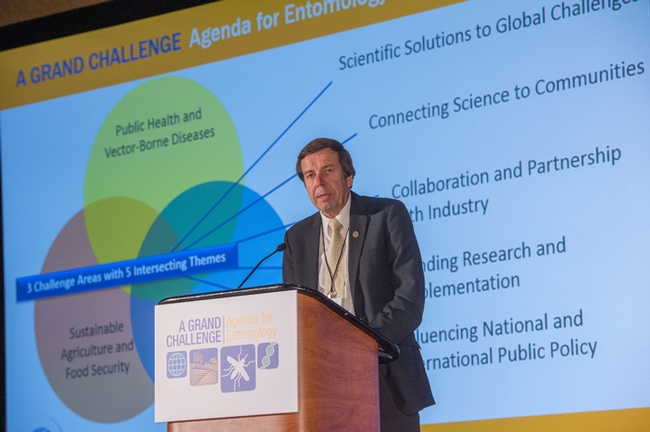

- Author: Kathy Keatley Garvey

Carey, a distinguished professor of entomology with the UC Davis Department of Entomology and Nematology, is considered the world's foremost authority on arthropod demography. Page, provost of Arizona State University and emeritus professor and former chair of the UC Davis Department of Entomology, is considered the most influential honey bee biologist of the past 30 years.
UC Davis chemical ecologist Walter Leal, co-chair of the International Congress of Entomology (ICE 2016), announced the names of the eight plenary speakers at the Entomological Society of America meeting, underway Nov. 16-19 in Portland, Ore. The process was highly competitive, he said, with 77 nominations worldwide.
The ICE conference, set Sept. 25-30, 2016, may be the largest gathering of entomologists ever. Some 6000 are expected to attend. It will be co-located with the annual meetings of the Entomological Society of America and the Entomological Society of Canada, along with events hosted by the entomological societies of China, Brazil, Australia, and others.
“We are delighted to have the first Hispanic woman (Latina) to give a plenary lecture at ICE; likewise, the first kiwi (New Zealander), as well as the first native African to have the opportunity to highlight their work in this venue,” said Leal, professor in the UC Davis Department of Molecular and Cellular Biology.
The list of plenary speakers:
- Carolina Barilla-Mury, National Institute of Allergy and Infectious Diseases, National Institutes of Health, Guatemala & USA, who will speak on medical entomology immunity
- Jacqueline Beggs, University of Auckland, New Zealand. Topic: biodiversity and biosecurity
- James R. Carey, University of California, Davis. Topic: insect biodemography
- Fred Gould, North Carolina State University. Topic: GMOs: crop and health protection
- Robert E. Page, Jr., Arizona State University. Topic: bee biology: Spirit of the Hive” (title of his latest book)
- José Roberto Postali Parra, ESALQ, University of Sao Paulo, Brazil. Topic: biological control.
- John A. Pickett, Rothamsted Research, UK. Topic: insect-plant interactions
- Baldwyn Torto, Centre of Insect Physiology & Ecology, based in Nairobi, Kenya. Topic: Colony collapse disorder and pollination.
Capsule information on the UC Davis-affiliated entomologists:

Carey has authored more than 250 scientific articles, including landmark papers in Science that shaped the way scientists think about lifespan limits and actuarial aging, and two articles in the Annual Review series that provide new syntheses on insect biodemography (2003, Annual Review of Entomology) and aging in the wild (2014, Annual Review of Ecology, Evolution, and Systematics). He directed a $10 million multi-university grant for more than a decade (2003-2013).
Carey is the author of three books, including Applied Demography for Biologists with Special Emphasis on Insects (Oxford University Press), the go-to source for all entomologists studying demography. Highly honored for his work, Carey received the 2014 C. W. Woodworth Award, the highest honor bestowed by the Pacific Branch of the Entomological Society of America (ESA), and the 2014 UC Davis Academic Senate Distinguished Teaching Award for innovative and creative teaching.
Carey chaired the University of California Systemwide Committee on Research Policy—one of the most important and prestigious committees in the UC system and served on the systemwide UC Academic Council. In addition, he serves as the associate editor of three journals: Genus, Aging Cell, and Demographic Research. In addition, he is the first entomologist to have a mathematical discovery named after him by demographers—The Carey Equality—which set the theoretical and analytical foundation for a new approach to understanding wild populations.
He is a fellow of four professional organizations: ESA, the Gerontological Society of America, the California Academy of Sciences and the American Association for the Advancement of Science.
Carey has presented more than 250 seminars in venues all over the world, from Stanford, Harvard, Moscow, Beijing to Athens, London, Adelaide and Okinawa. In addition, Carey is considered a worldwide authority on the demography and invasion biology of tephritid fruit flies, particularly the Mediterranean fruit fly; and a preeminent authority on biodemographics of human aging and lifespan. He is also a pioneering force advocating the educational use of digital video technology, work that he is sharing throughout much of the state, nation and the world.
Carey received his bachelor's degree (animal ecology, 1973) and master's degree (entomology, 1975) from Iowa State University, and his doctorate in entomology from UC Berkeley in 1980.

Page, who received his doctorate in entomology at UC Davis in 1980, served as an assistant professor at Ohio State University before joining the UC Davis Department of Entomology in 1989. He chaired the department for five years, from 1999 to 2004. Page's specialized genetic stock of honey bees was based for many years at UC Davis.
Page has published more than 200 reviewed publications, three edited books and two authored books. His lab pioneered the use of modern techniques to study the genetic bases to the evolution of social behavior in honey bees and other social insects.
Page was the first to employ molecular markers to study polyandry and patterns of sperm use in honey bees. He provided the first quantitative demonstration of low genetic relatedness in a highly eusocial species.
Among his other achievements involving honey bee research:
- Page and his students and colleagues isolated, characterized and validated the complementary sex determination gene of the honey bee; perhaps the most important paper yet published about the genetics of Hymenoptera.
- He and his students constructed the first genetic map of any social insect, demonstrating that the honey bee has the highest recombination rate of any eukaryotic organism mapped to date.
In addition, Page was personally involved in genome mappings of bumble bees, parasitic wasps and two species of ants. His most recent work focuses on the genetic bases to individuality in honey bees.
Page also built two modern apicultural labs (in Ohio and Arizona), major legacies that are centers of honey bee research and training. He has trained many hundreds of beekeepers, and continues to teach beekeeping even as provost of the largest public university in the United States. He is also the Foundation Chair of Life Sciences.
An internationally recognized scholar, Page is an elected foreign member of the Brazilian Academy of Science, a fellow of the American Association for the Advancement of Science, and an elected member of the American Academy of Arts and Sciences and the oldest scientific academy of science, the Germany Academy of Sciences Leopoldina. He was elected to Leopoldina, founded in 1652, for his pioneering research in behavioral genetics of honey bees.
Previously announced as keynote speakers: Nobel Laureautes Peter Agre (2003 Nobel Prize in Chemistry) and Jules Hoffmann (2011 Nobel Prize in Physiology or Medicine). Agre is the Bloomberg Distinguished Professor at the Johns Hopkins School of Medicine and Bloomberg School of Public Health. Hoffmann is a professor of integrative biology at the Strasbourg University Institute for Advanced Study. He is also emeritus research director of the French National Research Center and a past president of the French National Academy of Sciences.
The ICE conference, themed "Entomology without Borders," is co-chaired by Alvin Simmons research entomologist with the United States Department of Agriculture (USDA), Agricultural Research Service, U.S. Vegetable Laboratory in Charleston, S.C. More information on the conference is on its website at http://ice2016orlando.org/
- Author: Kathy Keatley Garvey

Hoffmann is a professor of integrative biology at the Strasbourg University Institute for Advanced Study. He is also emeritus research director of the French National Research Center, and he served as vice president and president of the French National Academy of Sciences from 2006-2010.
He is one of two Nobel Prize winners, along with Peter Agre (2003 Nobel Prize in Chemistry), to agree to speak at ICE 2016, which promises to be the largest gathering of insect scientists in history, with more than 6,000 attendees expected.
Hoffmann, who was awarded the Nobel Prize for “discoveries concerning the activation of innate immunity,” is an especially fitting speaker for an entomology conference. He and his colleagues used insects, namely the fruit fly Drosophila, to decipher the potent antimicrobial defenses. Over many years, these studies have led to a general understanding of recognition of infection by flies, the connections between recognition and signaling, and the subsequent control of expression of immune responsive genes, namely of those encoding antimicrobial peptides which oppose the invading microorganisms.
Hoffmann's interest in insects began at an early age and was inspired by his father, a high-school biology teacher in Luxembourg who worked on the systematics of various insect groups during his spare time.
“Most of my father's studies focused on Odonata, Ephemeroptera, Orthoptera, Dermaptera, and Hemiptera, and he was particularly interested in the development and behavior of mayflies,” Dr. Hoffmann said. “Under his guidance, and with his strong involvement, I published my first paper on the aquatic Heteroptera of Luxembourg.”
After high school in Luxembourg, Hoffmann attended the University of Strasbourg and worked on his Ph.D. with Professor Pierre Joly, a neuroendocrinologist, on the antimicrobial defenses of migratory locusts.
Hoffmann, who uses insects as model organisms to study the immune system, will talk about “Innate Immunity: from Insects to Humans” and illustrate how basic research on insects can lead to broader discoveries relevant to human health.
“We are absolutely delighted that Dr Jules Hoffmann has accepted our invitation to give a lecture in Orlando,” said Leal and Alvin Simmons, co-chairs of ICE 2016. “The appearance of Dr. Hoffmann and Dr. Peter Agre — two Nobel Prize winners — is unprecedented in the 104-year history of the International Congress of Entomology.”
The International Congress of Entomology is held once every four years in different countries around the world. The XXV International Congress of Entomology will be held in Orlando under the theme “Entomology without Borders.”
ICE 2016 is likely to be the largest gathering of entomologists in history, as it will be co-located with the annual meetings of the Entomological Society of America and the Entomological Society of Canada, along with events hosted by the Entomological Societies of China, Brazil, Australia, and others.
For more information about ICE 2016, please visit http://www.ice2016orlando.org.
(Richard Levine of ESA provided the information for this story)
- Author: Kathy Keatley Garvey

Agre shared the 2003 Nobel Prize in Chemistry for discovering aquaporins, a family of water-channel proteins found throughout nature that underlie numerous physiological processes and clinical disorders. He is deeply involved in multiple global issues, and is the current director of the Johns Hopkins Malaria Research Institute, which conducts research in Zambia and Zimbabwe.
From 2005-2008, Agre chaired the Committee on Human Rights of the National Academy of Sciences and led efforts on behalf of imprisoned scientists, engineers, and health professionals worldwide. He has also participated in diplomatic visits and meetings with leaders of Cuba, North Korea, Myanmar, and Iran.
A past president of the American Association for the Advancement of Science (AAAS), Agre is an ambassador for science. He has given numerous lectures and presentations, and has even appeared on the TV program The Colbert Report.
“We are honored to have Dr. Peter Agre as our keynote speaker,” said UC Davis chemical ecologist Walter Leal, co-chair of ICE 2016. “This will be a historic event with more than 6,000 attendees, and we look forward to hearing about Dr. Agre's efforts to control malaria, a mosquito-borne disease that kills more than 600,000 people each year.”
“Controlling malaria is definitely one of the grand challenges in the field of entomology,” said ICE 2016 co-chair Alvin Simmons. “Dr. Agre's perspectives as a scientist and as a communicator will be well appreciated by the thousands of international insect scientists and others who will be in attendance. ICE 2016 will be a student-friendly event, and Dr. Agre is approachable for one-on-one conversations with students.”
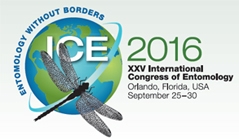
ICE 2016 will be the largest gathering of entomologists in history, as it will be co-located with the annual meetings of the Entomological Society of America and the Entomological Society of Canada, along with events hosted by the Entomological Societies of China, Brazil, Australia, and others.--Richard Levine, ESA
(Editor's Note: The two co-chairs planning the ICE conference are Walter Leal, former professor and chair of the UC Davis Department of Entomology, and now with the Department of Molecular and Cellullar Biology, and Alvin Simmons, research entomologist with the United States Department of Agriculture (USDA), Agricultural Research Service, U.S. Vegetable Laboratory in Charleston, S.C.)


